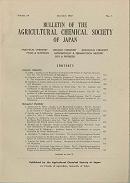All issues

Volume 15, Issue 3
Displaying 1-4 of 4 articles from this issue
- |<
- <
- 1
- >
- >|
-
II-Some Observations on the Nutritive Value of SugarsUme TANGE, Tetsuko KANEKO1939 Volume 15 Issue 3 Pages 23-29
Published: 1939
Released on J-STAGE: February 07, 2011
JOURNAL FREE ACCESS1. When sucrose was used at the basal carbohydrate, the rats developed dermatitis, whereas if sucrose was totally or partially substituted by “Kurozato”, “Ganmitsuto”, or cane molasses, no dermatitis resulted.
2. The concentrate of alcohol extracts of the crude sugars mentioned above cured the dermatitis occurring in the rats fed on sucrose diet and promoted growth, provided adequate amounts of vitamin B1 and flavin were fed simultaneously.
3. The data indicated that the concentrate of the crude sugars contained at least two factors essential for the nutrition of rats. One factor was adsorbed on acid clay, from which was eluted with 0.2NBa (OH)2, the other was present in the acid earth filtrate; and the former may be identical with vitamin B6 and the latter resembles the so-called filtrate factor.View full abstractDownload PDF (5276K) -
Kano OHTSU, Kazuo YAMAFUJI1939 Volume 15 Issue 3 Pages 30-32
Published: 1939
Released on J-STAGE: February 07, 2011
JOURNAL FREE ACCESSGewöhnlich enthält der Verdauungssaft des Insekts verschiedene Mikroben. Die Enzyme dieser Mikroorganismen sind in einigen Fallen an den Verdauungsvorgängen beim Insekt beteiligt. In den anderen Fällen wird aber die Vitalität des Insekts durch das Toxin der Bakterien oder Pilze im Digestionssaft geschädigt. Wir haben im Zuckerrohrfeld einige Gräshopfer gesammelt und das Garvermögen der aus ihren Verdauungsorganen isolierten Helen untersucht.View full abstractDownload PDF (348K) -
Yoshio OTANI1939 Volume 15 Issue 3 Pages 33-36
Published: 1939
Released on J-STAGE: February 07, 2011
JOURNAL FREE ACCESSThe author made a number of comparative experiments with regard to the morphology and physiology of various strains of Aspergillus Oryzae. The enzymatic characteristics may be divided into two, i. e., starch decomposer and protein decomposer. There were two characteristics of the metabolic product, i. e., acid producer and pigment producer. The morphology and physiology of the starch decomposer and the acid producer were very similar. Those of the protein decomposer and pigment producer were also very similar. Thus, we were able to place the starch decomposer and the acid producer in one group which has the power to act on carbohydrates. Both the protein decomposer and the, pigment producer were classified in the other group which acts on protein and on its decomposition products. In addition, among the various strains, there were some which were between the two classes mentioned above, and there were some which had the characteristics of both groups.View full abstractDownload PDF (499K) -
1939 Volume 15 Issue 3 Pages 37-48
Published: 1939
Released on J-STAGE: February 07, 2011
JOURNAL FREE ACCESSDownload PDF (1464K)
- |<
- <
- 1
- >
- >|